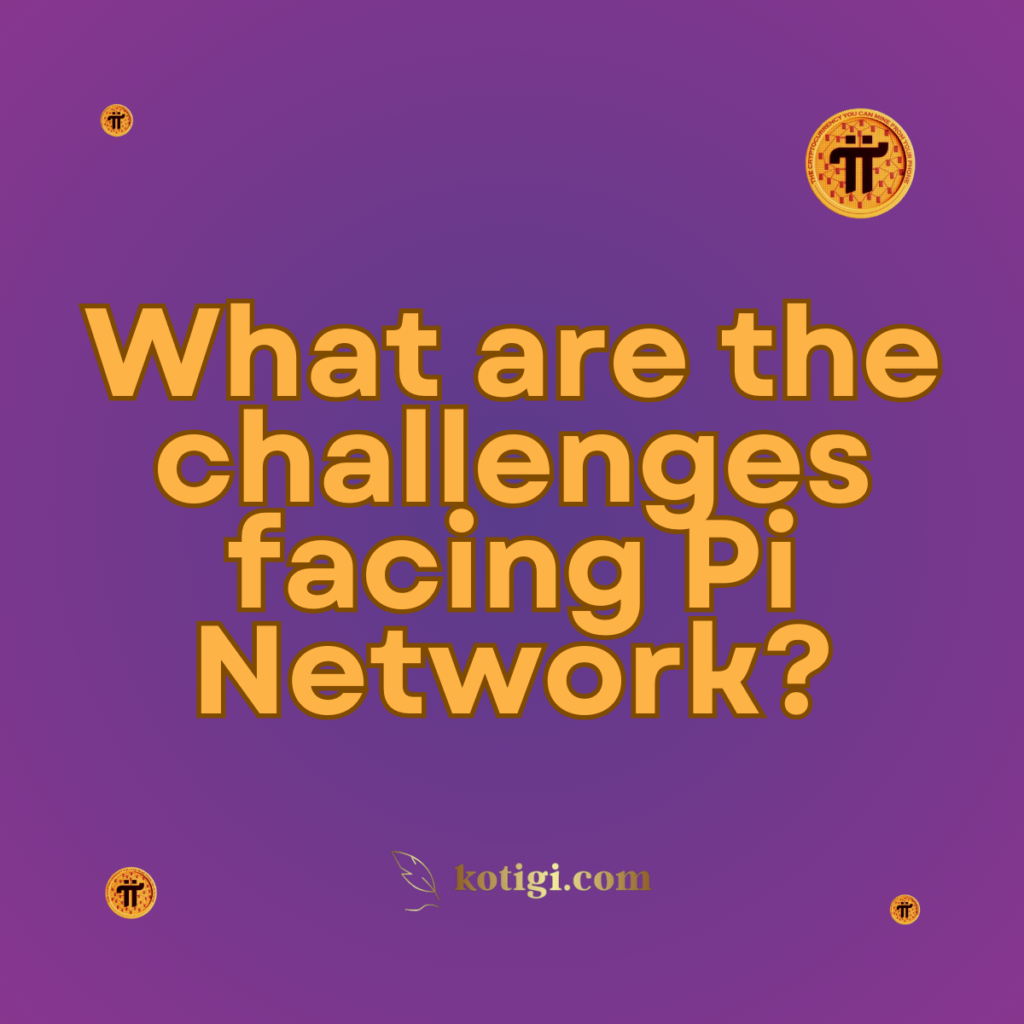
What are the challenges facing Pi Network?
Pi Network faces several challenges as it transitions from a mobile mining platform to a fully operational cryptocurrency. These challenges include scalability, regulatory concerns, user trust, and competition in the crowded blockchain industry…
Introduction
Pi Network has gained significant traction since its inception, attracting millions of users with its mobile mining concept and vision for a decentralized cryptocurrency accessible to everyone. Despite its promising start, the platform faces numerous challenges as it moves towards launching its mainnet and building a sustainable ecosystem. In this article, we’ll explore some of the key challenges facing Pi Network, including technological, regulatory, and market-related obstacles that could affect its long-term success.
Table: Major Challenges Facing Pi Network
| Challenge | Description | Impact on Pi Network | Possible Solutions |
|---|---|---|---|
| Scalability Issues | Difficulty managing a growing user base and large transaction volume. | Could slow down the network, reduce transaction efficiency, and affect user experience. | Implementing layer-2 solutions, optimizing node operations, and enhancing blockchain protocols to improve speed and capacity. |
| Regulatory Uncertainty | Navigating complex, often conflicting cryptocurrency regulations across multiple countries. | Delays in deployment, potential bans in certain jurisdictions, legal challenges in markets with strict crypto regulations. | Establishing a strong legal team, ensuring compliance with global KYC/AML regulations, and partnering with regulatory bodies for guidance. |
| Trust and Credibility | Skepticism about the legitimacy of mobile mining and delays in launching the mainnet. | Reduced user confidence and community morale, potential user drop-off, and negative media coverage. | Providing regular, transparent updates on project progress and tackling misinformation and scams surrounding the Pi Network. |
| Competition in Blockchain Space | Competing with well-established blockchain networks such as Ethereum and Binance Smart Chain. | Difficulty gaining developer interest, securing adoption, and sustaining long-term user engagement. | Focusing on unique value propositions such as ease of access, and leveraging a large user base to foster partnerships and collaborations. |
| Monetization and Sustainability | Building a sustainable economic model for Pi coins, with real-world value and widespread adoption. | Pi coins could face low liquidity and value, affecting user motivation and merchant adoption. | Introducing new use cases, promoting merchant acceptance of Pi coins, and ensuring incentives for holding and transacting Pi are well-balanced. |
| Technological Development | Ensuring continuous development of the Pi blockchain infrastructure, keeping it up-to-date with industry standards. | A slow pace of innovation could render Pi Network obsolete or less attractive compared to competitors. | Investing in research and development, keeping the network scalable, secure, and decentralized through regular upgrades and enhancements. |
| Liquidity and Exchange Listings | Lack of Pi’s availability on major cryptocurrency exchanges and low liquidity. | Limited liquidity means users cannot easily trade or convert Pi coins into other cryptocurrencies or fiat. | Securing listings on top exchanges, building liquidity pools, and establishing strategic partnerships with crypto trading platforms. |
| User Education and Adoption | Educating users on blockchain technology, the value of Pi, and encouraging its use in daily transactions. | Limited understanding may reduce user retention, slow down the ecosystem growth, and hinder merchant adoption. | Offering educational resources, webinars, and tutorials to onboard users, while partnering with businesses to incentivize real-world use of Pi coins. |
| Security and Decentralization | Maintaining high security standards while keeping the network decentralized. | Any security breaches or centralization concerns could undermine trust in the Pi Network and compromise user data. | Regular security audits, bug bounty programs, and transparent governance processes to balance decentralization with efficiency. |
This table provides a clear, in-depth look at Pi Network’s major challenges, their potential impact on the platform, and possible strategies for overcoming these obstacles.
1. Scalability Issues
1.1 Growing User Base
With millions of users already participating in Pi Network, scaling its blockchain infrastructure is critical. The platform must ensure that it can handle a large volume of transactions without compromising speed or security.
1.2 Blockchain Efficiency
Blockchain networks like Bitcoin and Ethereum have faced scalability issues in the past. Pi Network must learn from their experiences to create a system that balances decentralization and transaction efficiency.
1.3 Node Validation
Pi Network’s current phase involves node validation by community members. Ensuring that the network remains decentralized and can manage large-scale participation is a key challenge.
1.4 Energy Efficiency
While Pi Network promotes itself as energy-efficient compared to traditional mining, as the user base grows, ensuring that its energy consumption remains low will be vital.
2. Regulatory Uncertainty
2.1 Global Cryptocurrency Regulations
Cryptocurrency regulations vary greatly from one country to another. Pi Network must navigate different legal frameworks, particularly in jurisdictions with strict regulations regarding cryptocurrency and digital assets.
2.2 Know Your Customer (KYC) Compliance
Pi Network has implemented a KYC process to verify users’ identities. However, ensuring global compliance with KYC standards while maintaining user privacy remains a balancing act.
2.3 Anti-Money Laundering (AML) Policies
Regulatory authorities are increasingly focusing on preventing money laundering through cryptocurrencies. Pi Network must ensure its compliance with AML policies, which may require additional resources and legal frameworks.
3. Trust and Credibility
3.1 Skepticism Around Mobile Mining
Some potential users are skeptical about the legitimacy of mobile mining, which is a relatively new concept in the cryptocurrency world. Overcoming these doubts and building trust within the community is a major hurdle.
3.2 Delays in Mainnet Launch
Pi Network has faced criticism for delays in launching its mainnet, leading some to question whether the platform will deliver on its promises. Regular and transparent communication will be essential to maintaining user trust.
3.3 Scams and Misrepresentation
Pi Network’s popularity has also led to the rise of scams and misrepresentations surrounding its ecosystem. Controlling this narrative and protecting users from fraudulent activities is a constant challenge.
4. Competition in the Blockchain Space
4.1 Competing Blockchain Projects
Pi Network operates in a highly competitive environment, with numerous established and emerging blockchain projects offering decentralized solutions. Competing for market share will require unique innovations and community engagement.
4.2 User Retention
Retaining users in a space crowded with alternative projects is an ongoing battle. Pi Network needs to continuously improve its offerings and create incentives for users to stay within its ecosystem.
4.3 Adoption by Developers
The success of any blockchain project heavily depends on developer adoption. If Pi Network fails to attract developers to build decentralized applications (dApps) on its platform, it could struggle to remain relevant.
5. Monetization and Sustainability
5.1 Creating a Functional Economy
For Pi Network to thrive, it needs to create a functional economy where Pi coins have real-world value. This involves creating partnerships and use cases that go beyond just trading or holding Pi coins.
5.2 Building a Sustainable Ecosystem
Ensuring long-term sustainability will require more than just user growth. Pi Network needs to develop a self-sustaining ecosystem that can support both its users and developers.
5.3 Economic Incentives
Developing fair and sustainable reward structures for miners, developers, and other participants is another challenge. The reward system must ensure value for users without causing inflationary pressure on Pi coins.
6. Technological Development
6.1 Continuous Upgrades
As the blockchain industry evolves, Pi Network must continuously upgrade its technology to stay competitive. Failing to keep up with advancements could leave the network outdated and less attractive to users.
6.2 Security Protocols
Blockchain security is paramount, and Pi Network needs to ensure its infrastructure is secure from hacking and other cyber threats. Maintaining robust security measures is an ongoing challenge for any cryptocurrency project.
6.3 Decentralization
Ensuring that the network remains truly decentralized while achieving the necessary speed and efficiency is a technical challenge Pi Network must overcome.
7. Liquidity and Exchange Listings
7.1 Limited Exchange Listings
As of now, Pi is not listed on major cryptocurrency exchanges, which limits liquidity and trading options for users. Securing partnerships with exchanges will be critical for Pi’s future success.
7.2 Price Volatility
Even if Pi gets listed on major exchanges, price volatility remains a challenge for any new cryptocurrency. Pi Network needs to ensure that its economic model can handle fluctuations without undermining user trust.
7.3 Cross-Chain Compatibility
Building cross-chain compatibility with other blockchains could increase Pi’s usability and liquidity. However, integrating with other blockchain networks is a complex and resource-intensive process.
8. User Education and Adoption
8.1 Educating Users About Blockchain
Despite the growing popularity of cryptocurrencies, many users still lack a deep understanding of blockchain technology. Pi Network must invest in educational initiatives to ensure its users can fully participate in and benefit from its ecosystem.
8.2 Convincing Merchants to Accept Pi
One of the key challenges Pi Network faces is convincing merchants to accept Pi as a valid form of payment. Without widespread merchant adoption, the practical use of Pi remains limited.
8.3 Onboarding Non-Technical Users
Pi Network’s goal is to be accessible to everyone, including non-technical users. Simplifying the user interface and creating easy-to-follow guides will be necessary for attracting a broader audience.
Conclusion
While Pi Network has made significant strides in building a large, engaged community, the platform faces numerous challenges as it strives to launch its mainnet and achieve long-term success. From scalability issues and regulatory compliance to maintaining user trust and staying competitive in the blockchain space, Pi Network has its work cut out. Overcoming these obstacles will require strategic planning, robust partnerships, and continuous innovation.
Key Takeaways
| Challenges | Details |
|---|---|
| Scalability Issues | Handling millions of transactions and ensuring network efficiency. |
| Regulatory Uncertainty | Complying with global KYC, AML, and cryptocurrency regulations. |
| Trust and Credibility | Overcoming skepticism and maintaining user trust amid delays and scams. |
| Competition | Competing against other established blockchain projects for users and market share. |
| Monetization and Sustainability | Building a functional economy and sustainable ecosystem for long-term success. |
| Technological Development | Continuously upgrading security, efficiency, and decentralization protocols. |
| Liquidity and Exchange Listings | Gaining liquidity through exchange listings and managing price volatility. |
| User Education and Adoption | Educating users about blockchain and increasing real-world use cases for Pi. |



